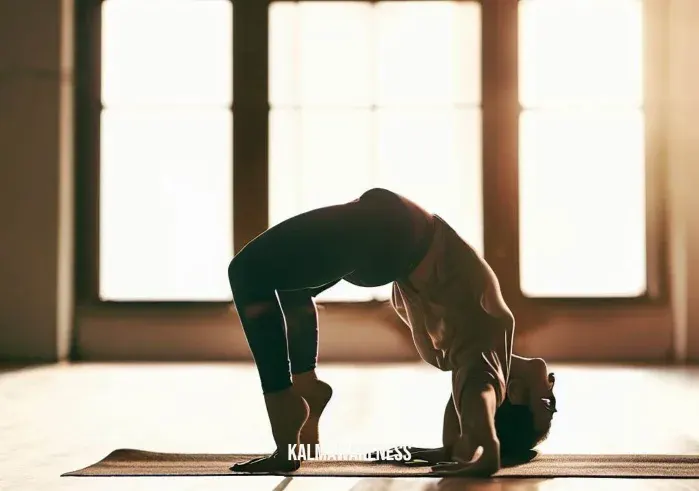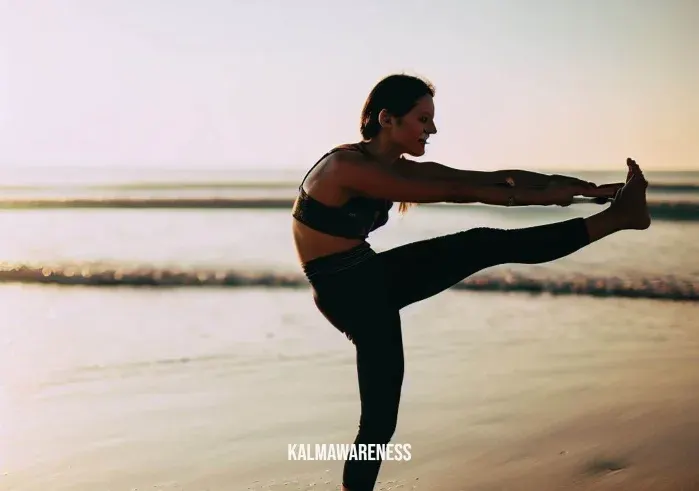Yoga Pose: Side Crow Pose Yoga
| Description | Explanation |
|---|---|
| Pose Name | Side Crow Pose Yoga |
| Original Name | Parsva Bakasana |
| Difficulty Level | Intermediate |
| Pose Category | Arm Balances |
| Exercise Duration | Beginners: 30 seconds to 1 minute, Advanced: 1 to 2 minutes |
Yoga poses are not only a physical practice but also a journey of self-discovery and inner balance. One such pose that challenges both the body and the mind is the Side Crow Pose Yoga, also known as Parsva Bakasana. In this article, we will explore the intricacies of this intermediate-level arm balance pose and uncover the transformative power it holds. So, roll out your yoga mat, take a deep breath, and let’s dive into the world of Side Crow Pose Yoga!
Understanding Side Crow Pose Yoga
Side Crow Pose Yoga, as the name suggests, is a variation of the Crow Pose where the body is twisted to one side. This pose primarily targets the core, arms, and wrists, while also engaging the muscles of the legs and shoulders. It requires a combination of strength, flexibility, and focus to achieve and hold the pose.
Benefits of Side Crow Pose Yoga
Before we delve into the step-by-step guide, let’s explore the benefits that Side Crow Pose Yoga has to offer:
- Strengthens the Core: Side Crow Pose Yoga is an excellent way to build core strength and stability. The twisting motion activates the deep abdominal muscles, helping to tone and sculpt the midsection.
- Enhances Arm and Wrist Strength: As an arm balance pose, Side Crow Pose Yoga strengthens the arms, forearms, and wrists. Regular practice can improve upper body strength and increase the stability of the wrists.
- Improves Balance and Focus: Balancing on one arm while twisted challenges your balance and concentration. Practicing Side Crow Pose Yoga enhances your proprioception and focus, both on and off the mat.
- Stimulates Digestion: The gentle compression on the abdominal organs during this pose stimulates digestion and aids in detoxification, promoting a healthy digestive system.
- Boosts Confidence and Self-Esteem: As you gradually master Side Crow Pose Yoga, your confidence grows. This sense of accomplishment can extend beyond the mat, positively influencing your self-esteem.
Step-by-Step Guide: Finding Your Side Crow
Now, let’s explore the step-by-step instructions to practice Side Crow Pose Yoga:
- Warm-Up: Begin by warming up your body with a few rounds of Sun Salutations or any other dynamic flow that focuses on stretching the wrists, arms, and core.
- Squat and Twist: Start in a squat position with your feet hip-width apart. Bring your palms together at your heart center and twist to the right, placing your left elbow on the outside of your right thigh.
- Plant the Hands: As you continue to twist, place your hands shoulder-width apart on the mat, slightly forward of the twisted side.
- Lift the Hips: Engage your core and shift your weight onto your hands as you lift your hips off the ground. Your knees will be stacked on top of each other, with the twisted side elbow pressing gently into the thigh.
- Engage the Core: As you balance, draw your navel towards your spine and engage your core muscles. This will help stabilize your body and maintain the pose.
- Gaze Forward: Direct your gaze forward, finding a focal point to enhance your balance and concentration.
- Lift the Feet: Slowly begin to lift your feet off the ground, keeping your focus and core engagement strong. Start by lifting one foot, and as you gain confidence, lift the other foot as well.
- Balance and Breathe: Find your balance in Side Crow Pose Yoga and take deep, steady breaths. Stay in the pose for the desired duration, allowing yourself to experience the strength and stability it brings.
Continue to Part 2 of the article to uncover variations and modifications of Side Crow Pose Yoga, along with tips for beginners and advanced practitioners. Get ready to soar to new heights and unlock the full potential of this empowering yoga pose!

Yoga Pose: Side Crow Pose Yoga
Benefits, Modifications, and Variations
In Part 1, we introduced you to the captivating world of Side Crow Pose Yoga (Parsva Bakasana). Now, let’s continue our exploration by delving into the incredible benefits of this pose, understanding who can benefit from it, and exploring variations suitable for practitioners of different levels.
Benefits of Side Crow Pose Yoga
Side Crow Pose Yoga offers a wide range of benefits for both the body and the mind. Let’s take a closer look at the positive impacts it can have on your overall well-being:
- Core Strength and Stability: As you balance on one arm in Side Crow Pose Yoga, your core muscles, including the obliques and transverse abdominis, are engaged and strengthened. This helps improve your overall core strength and stability, enhancing your posture and body control.
- Arm and Wrist Strength: Holding Side Crow Pose requires significant upper body strength, particularly in the arms and wrists. Regular practice can help build strength in these areas, promoting better alignment and stability in various yoga poses and everyday activities.
- Improved Concentration: Balancing on one arm while twisting challenges your focus and concentration. By practicing Side Crow Pose Yoga, you train your mind to stay present and attentive, improving your ability to concentrate and find mental clarity.
- Enhanced Spinal Mobility: The twisting motion in Side Crow Pose stimulates and massages the spine, promoting spinal flexibility and mobility. This can help alleviate stiffness and tension in the back, promoting a healthier and more agile spine.
- Building Confidence: Successfully mastering Side Crow Pose can significantly boost your self-confidence. As you overcome challenges and achieve balance and stability in this pose, you develop a sense of empowerment and self-assurance that extends beyond your yoga practice.
Suitability and Precautions
While Side Crow Pose offers numerous benefits, it may not be suitable for everyone. It is essential to consider your own body and limitations before attempting this pose. Here are a few factors to keep in mind:
- Not Recommended for Beginners: Side Crow Pose is an intermediate-level arm balance that requires a certain level of upper body and core strength. It is advisable to establish a regular yoga practice and gain familiarity with foundational poses before attempting Side Crow Pose.
- Wrist or Shoulder Injuries: Individuals with wrist or shoulder injuries or conditions should approach Side Crow Pose with caution. It’s crucial to listen to your body and avoid any movements or sensations that cause discomfort or pain. Consult with a qualified yoga instructor or healthcare professional for guidance.
- Pregnancy: Pregnant individuals should avoid practicing Side Crow Pose due to the increased risk of imbalance and potential strain on the abdominal muscles. It is best to focus on prenatal yoga sequences specifically designed for expectant mothers.
Variations for Different Levels
Side Crow Pose Yoga offers various modifications and variations that cater to practitioners of different levels of experience. Here are a few variations you can explore:
- Supported Side Crow: For beginners or those still developing the required strength, using a yoga block or bolster can provide support and stability. Place the block under your forehead or chest as you practice the pose, allowing you to focus on balance and alignment without the fear of falling forward.
- Extended Leg Side Crow: Once you feel comfortable in Side Crow Pose, you can experiment with extending one leg straight out while balancing. This variation increases the challenge and strengthens the core and hip flexors.
- One-Legged Side Crow: Advanced practitioners can explore lifting one leg off the ground while in Side Crow Pose. This variation requires heightened focus and engagement of the core and leg muscles to maintain balance and stability.
Remember to listen to your body, progress at your own pace, and always practice with mindfulness and awareness. It’s essential to honor your body’s limitations and respect the journey of your practice.
Congratulations on completing Part 2 of our article on Side Crow Pose Yoga! In the next part, we will explore the connection between Side Crow Pose and breathwork, as well as introduce additional poses that complement and enhance your arm balance practice. Get ready to take your yoga journey to new heights! Stay tuned for Part 3.

History, Spiritual Significance, Tips, and Modifications
Welcome to Part 3 of our comprehensive exploration of Side Crow Pose Yoga (Parsva Bakasana). In this section, we will uncover the intriguing history behind this pose, delve into its spiritual significance, provide valuable tips for maximizing its benefits, discuss common mistakes to avoid, explore modifications for those with injuries or limited flexibility, and introduce complementary poses to enhance your practice.
The History of Side Crow Pose Yoga
Like many yoga poses, Side Crow Pose has roots that trace back to ancient yoga traditions. While the exact origins may be challenging to pinpoint, this pose has been practiced for centuries, passed down through generations of yogis seeking physical, mental, and spiritual transformation. Incorporating this pose into your practice connects you to the vast legacy of yoga and its profound impact on the human experience.
Spiritual Significance of Side Crow Pose Yoga
Beyond its physical benefits, Side Crow Pose holds spiritual significance. As you twist and balance in this pose, you activate and harmonize the energy centers in your body, known as chakras. This pose particularly stimulates the Manipura (solar plexus) and Anahata (heart) chakras, promoting feelings of personal power, inner strength, and compassion.
Side Crow Pose also cultivates a sense of courage and confidence. By embracing the challenges of this pose, you tap into your inner reservoir of bravery and learn to trust yourself both on and off the mat. The pose encourages you to embrace your unique potential and shine your light brightly, spreading positivity and love to the world around you.
Tips for Getting the Most out of Side Crow Pose Yoga
To deepen your practice and experience the full benefits of Side Crow Pose, consider incorporating the following tips into your routine:
- Engage the Core: Maintain a strong engagement of your core muscles throughout the pose. This not only helps with balance but also activates the deep core muscles, creating a stable foundation for the pose.
- Use the Breath: Remember to breathe deeply and evenly while in Side Crow Pose. Focus on smooth inhalations and exhalations, allowing the breath to anchor your awareness and create a sense of calm and presence.
- Play with Alignment: Experiment with the alignment of your arms, wrists, and elbows to find the optimal position that feels comfortable and supportive for your body. Adjusting these aspects can significantly impact your stability and ease in the pose.
- Maintain Softness: While Side Crow Pose requires strength, it’s important to balance strength with softness. Avoid unnecessary tension in your muscles and aim for a sense of lightness and ease throughout the pose.
Common Mistakes to Avoid
As you practice Side Crow Pose, be mindful of the following common mistakes and strive to avoid them:
- Collapsing the Chest: Avoid collapsing the chest and shoulders forward. Instead, actively lift and broaden the chest to create space and stability in the upper body.
- Neglecting the Core: Neglecting core engagement can lead to instability in Side Crow Pose. Remember to activate your core muscles and draw them in towards your spine to support the pose.
- Placing Excessive Weight on the Wrists: Distribute your weight evenly through the hands and avoid excessive pressure on the wrists. Engage the muscles of your arms and shoulders to support the weight of your body.
- Forcing the Pose: Avoid forcing yourself into the pose if you feel any pain or discomfort. Listen to your body and respect your limitations. Progress gradually and with patience, allowing your body to adapt and grow stronger over time.
Modifications for Injuries or Limited Flexibility
If you have injuries or limited flexibility, you can still experience the benefits of Side Crow Pose with the following modifications:
- Block Support: Place a yoga block under your feet or hands to provide additional support and stability. This modification can help you gradually build strength and confidence in the pose.
- Knee-to-Arm Variation: Instead of lifting both feet off the ground, try resting one knee on the upper arm while balancing in Side Crow Pose. This modification reduces the demand on the wrists and arms while still engaging the core and building strength.
Remember to honor your body’s needs and work within your individual range of motion. If you have any concerns or specific conditions, consult with a qualified yoga instructor or healthcare professional for personalized guidance.
Complementary Poses to Enhance Your Practice
To complement and deepen your Side Crow Pose practice, explore the following poses:
- Crow Pose (Bakasana): Mastering Crow Pose provides a solid foundation for Side Crow Pose. It strengthens the arms, wrists, and core while improving balance and focus.
- Plank Pose (Phalakasana): Plank Pose builds upper body strength and core stability, preparing you for the arm balance challenges of Side Crow Pose.
- Revolved Triangle Pose (Parivrtta Trikonasana): This standing twist pose promotes spinal flexibility and strengthens the legs and core, providing a helpful preparation for the twists involved in Side Crow Pose.
- Boat Pose (Navasana): Boat Pose strengthens the core and hip flexors, enhancing the stability and control necessary for Side Crow Pose.
By incorporating these complementary poses into your regular practice, you can create a well-rounded and empowering yoga experience.





